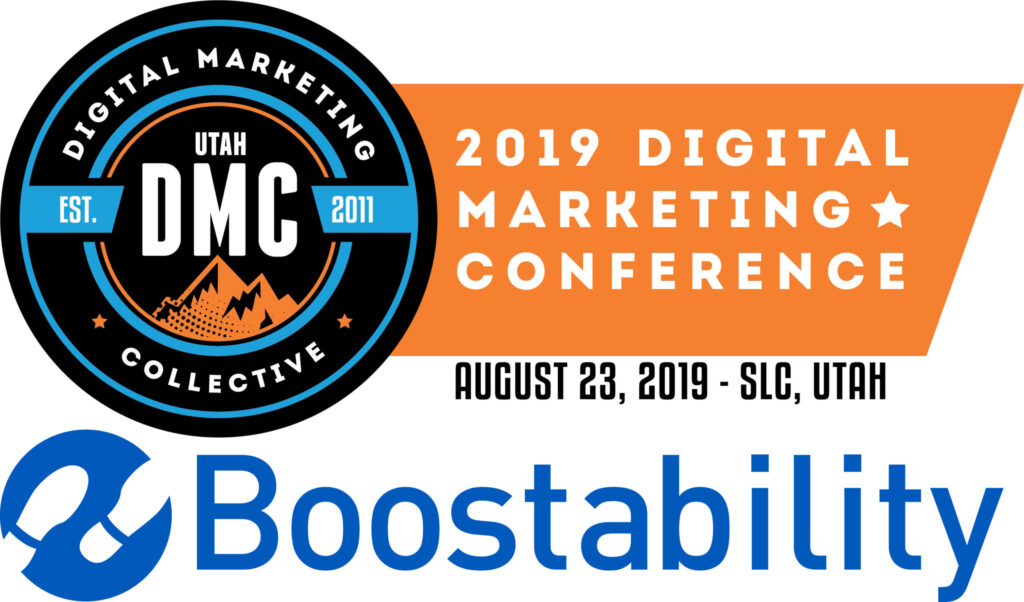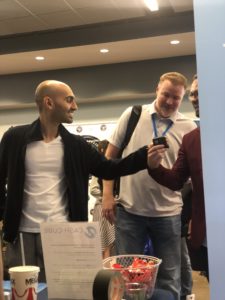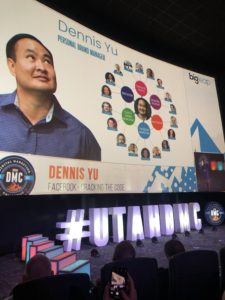Utah DMC 2019 | Key Takeaways to Boost Your Digital Marketing Efforts

The Utah Digital Marketing Collective (DMC) held their annual conference on August 23, 2019, in Sandy, Utah. As the content specialist for Boostability, I was tasked with covering the sessions and coming up with an easy-to-digest breakdown of what we, as a marketing team, learned by attending. The sessions covered huge swaths of topics, from video marketing to Facebook funnels, and we’re covering some of our favorite sessions here!
Marcus Sheridan | The Visual Sale: How to Embrace the Visual Revolution and Create a Culture of Video in Your Organization
Marcus was the first keynote speaker to address the conference attendees, and he did not disappoint. He radiated a sense of confident enthusiasm as he told us how video marketing and being transparent with pricing revolutionized his businesses.
Marcus had a fiberglass pool company, which did fairly well until the 2008 recession hit. Fiberglass pools weren’t exactly a hot commodity, and as the market started to slowly trip its way back up, he had to figure out a way to make them seem more accessible.
He did that in a few different ways. One of the most successful was a blog post he wrote that answered a simple question: “How much does a fiberglass pool cost?” While the messaging may seem deceptively simple, it did the job—to date, it’s made made over seven million dollars (yeah, you read that right—seven million). Turns out, when you’re open and honest about your prices, customers trust you more. They’re also willing to shell out the big bucks for your product, which doesn’t hurt either.
The 7 Videos Every Company Should Have
In Marcus’ talk, he also established that establishing a sense of trust cannot be understated. He covered the seven videos every company should have available on their site:
- The 80% video, which covers the questions sales reps get 80% of the time.
- The landing page videos, which should accompany any form fields on the site telling customers exactly what to expect after giving you their information.
- The bio videos, which feature customer-facing employees giving a short introduction to themselves and their role. This video often gets embedded in email signatures.
- Product service pages video, which tell the customer who your product is not for, making it easier than ever to build a client base in-line with your ability to deliver.
- Cost/price videos, which give a no-frill overview of your pricing structure.
- The claims you make video, which walks a customer through your business’ promises and how you make good on them
- The customer’s journey video, which features a real-life customer and how your product, service, or business solved a problem for them.
We were really impressed with the reach these kinds of videos had for Marcus’ clients, and we’re looking forward to talking with our sales team to see how we can better integrate our marketing efforts to their end goals.
Neil Patel | The Future of Digital Marketing: It’s Not What You Think
Neil is a big deal in the digital marketing world, and his keynote address proved why. With clear, concise messaging and an easy-to-get-started approach, here’s what we learned from Neil.

His big focus is the concept of “omni-channel” digital marketing—focusing on just one or two ways to communicate with clients just isn’t going to cut it anymore. Clients want to really know the companies they buy from, and the only way to do that is to publish content everywhere.
So how do I do it?
Neil suggested duplicating content across these different channels. While the phrase “duplicate content” may strike fear into the heart of a digital marketer, Neil assured us that it shouldn’t. He explained Google doesn’t penalize for duplicate content posted across different channels. Your company should feel free to use the same message in a Facebook update, a blog post, or a social media connection. It ensures your content gets to the largest amount of people and helps you rank better in the SERPs because you’re providing content in several different ways.
He was also adamant that marketers recycle their old content. Lots of older content often outperforms the newer stuff, so finding a way to keep it intentionally top of mind is key. Neil suggested updating the content every so often. Just note in the text of the copy itself to tell readers when it was last refreshed. It cuts down the time it takes to draft new stuff all while ensuring the work you share with customers does its job.
But all of this is moot if you don’t interact with your clients themselves. Posting great content in lots of places only works effectively if you show that you’re listing to your clients when they engage with it. Answer questions in the comments section. Ask for feedback in the description on a Youtube video. Run polls in Instagram stories. When everyone’s involved, your business moves forward.
Dan Gingiss | How a Remarkable Customer Experience Can Be Your Best Marketing
Try as you might, customers share complaints on social media than just about anything else. You may get some positive reviews, but generally customer comments fall at the extreme ends of the satisfaction spectrum. Your goal should focus on converting the “meh” customers into fans of your brand. You do this by being W.I.S.E.R.: witty, immersive, shareable, extraordinary, and responsive. Simple, easy, and an acronym we won’t forget.
Michelle Morgan | PPC Lead Generation Strategies for Quantity, Quality, and Revenue
Michelle started her presentation with a very simple truth: we like short things. Think Usain Bolt versus marathon runners—one is way more interesting than the other.
There are lots of prices we list to consumers: time, information, and attention. Our Calls to Action (CTAs) essentially ask customers to make a purchase. There’s a strategy to doing it right. Demos are the most expensive kind of CTA, but often the one sales people jump to first. But consumers are 131% more likely to convert after reading an educational piece of content. This means marketers should spend more time ensuring their customers have access to those educational resources. White papers, industry reports, and webinars can all provide effective learning experiences for potential customers.
You also need to make sure you have CTAs at every stage of the sales funnel. One just isn’t enough.
Ian Lurie | Everything I Needed to Know About Digital Marketing I Learned Playing Dungeons & Dragons
Here at Boost, we’re nerdy, and we know it. Ian’s presentation definitely struck a chord with us. So here are the biggest lessons D&D can teach us about digital marketing.
First off, know your role. Consider Marketing as the Dungeon Master, because they create the story and set the tone. Your target audience comprises the players. But here’s the important bit—the players control the game, not the master. While the dungeon master can set the tasks they’d like their audience to accomplish, the players still get to decide what they’ll do and how they’ll get there.
A good dungeon master will minimize the randomness that comes from playing with players who vary in skill set and intention. Marketers should do the same. While you can’t control everything, you must control what you can and try to plan for what you can’t.
Reward attention with high ROI. Your players give you their time before they give you their money, so make sure you show them why it’s worth it.
And above all else, be good. Sometimes players will decide the evil route is more fun. But in the end, everything works against them. Keep things above board and you’ll get the players to the finish line.
Dennis Yu | Facebook—Cracking the Code

Dennis’ presentation revolved around a single idea: the one-minute video.
Dennis worked to revolutionize the way we use video marketing in order to make it more personal and more effective. He shared with us the magic of a one-minute video you can stream across all your social platforms, and how simple it is to make it memorable.
There are three ways your video can start:
- When I was _______ . . .
- I believe that _______ . . .
- I am _______ . . .
And from there, you tell a story.
But Dennis didn’t just tell us how to do it—he showed us. Take a look at his one-minute video from the conference itself. (Can you spot us?)
These videos may lack the clean-cut look of professionally shot and edited ones lots of companies share on their channels. But there’s something to be said for the uniquely personal touch these self-recorded one-minute videos allow viewers to experience. Using these 60-second opportunities to tell stories about your brand, company, or product on a consistent basis effectively and affordably gets your customers invested in the narrative.
But what’s the TL;DR?
There’s this, from Marcus Sheridan:
They must see us before we see them.
They must hear us before we hear them.
They must know us before we know them.
The Utah DMC got us hyped to take Boost’s marketing efforts to a new level. We can help you get ready, too. Learn more by clicking here.
Looking for more Utah DMC 2019 coverage? We’ve got you. Check out our social channels on Facebook, Instagram, and Twitter, and more blog posts here.

